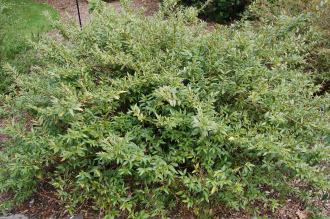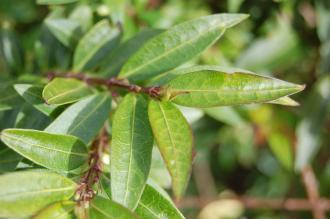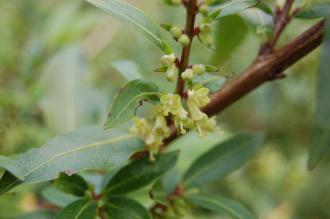
Lonicera pileata (19/04/2014, Kew Gardens, London)
Position: Full sun to partial shade
Flowering period: Late spring
Soil: Moist, well drained
Eventual Height: 60cm
Eventual Spread: 2m
Hardiness: 5b, 6b, 7a, 7b, 8a, 8b, 9a
Family: Caprifoliaceae
Lonicera pileata is a fast growing, compact evergreen shrub with a spreading bushy habit. Its dark green leaves are lanceolate with entire margins, up to 3cm long and 1cm broad. Its white/ cream fragrant flowers are tubular, up to 8mm long and are borne in pairs. Its fruit is a purple berry which is about 6mm in diameter.

Lonicera pileata Leaf (19/04/2014, Kew Gardens, London)
Lonicera pileata, commonly known as Boxleaf Honeysuckle or Privet Honeysuckle, is native to central and south west China. In its native habitat it grows in scrubby conditions. This shrub is becoming naturalised in the UK.
The etymological root of the binomial name Lonicera is derived from the name of Adam Lonicer, a German naturalist from the 16th century. Pileata is derived from the Latin pileus meaning ‘capped’.
The landscape architect may find Lonicera pileata useful as a robust evergreen ground cover plant. It also makes an effective low hedging species. Once established this plant is drought tolerant. This shrub is tolerant of maritime conditions.

Lonicera pileata Flower (19/04/2014, Kew Gardens, London)
Ecologically, Lonicera pileata flowers are attractive to pollinating insects. Its berries are attractive to birds.
Lonicera pileata prefers moist, fertile, well-drained soils. It tolerates most pH of soil.
Lonicera pileata requires little maintenance. If maintained as a hedge, it may be clipped three times a year to maintain its shape.

